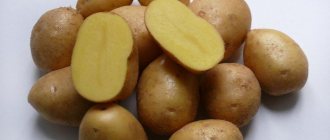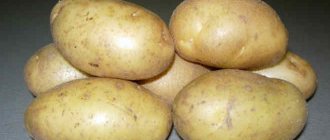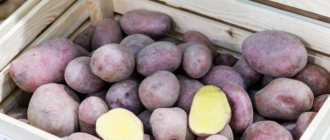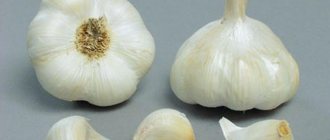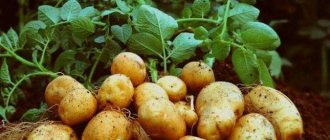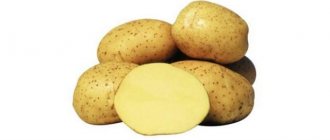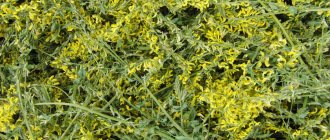Potatoes of the Gypsy variety with purple skin are not often seen on the market; the fact is that they are almost never grown on an industrial scale due to their thin skin, which is damaged during mechanical harvesting, storage and transportation. Occasionally, the variety can be seen in garden plots or cottages, where it is grown from seeds collected with one’s own hands.
Gypsy
Description of appearance and photo of potatoes
Escapes
Potato shoots are colored bright dark green . The veins are clearly visible on the wavy leaves along the edges. The bushes are not very spreading and are small in size. Stems are dark. Potatoes bloom with bright blue large flowers collected in inflorescences.
Roots
The roots of this hybrid are distinguished by a rich purple color. They have an oval-round shape. The peel is thin, smooth, glossy. The eyes are shallow. The pulp is tender, creamy or beige in color. This variety is not distinguished by uniformity in the size of its root crops.
Botanical description
Gypsy can be called both an early and mid-early variety, since the ripening period depends on the climate in the growing region.
Tubers
The tubers are elongated-oval in shape and have a smooth surface without ribs or dents. On the glossy thin skin of a light ink color, a few, shallow eyes are barely noticeable. The weight of the tuber is on average 100–130 g. When cut, the tuber shows creamy pulp, sometimes with purple splashes.
Large tubers stand out not only for their spectacular appearance, but also for their taste and nutritional qualities. The main characteristics of this variety make it possible to classify it as a gourmet and dietary variety. The taste is rich, potato-like, the flesh is tender, medium-starchy, does not soften when cooked, and does not darken when cut. Potatoes retain their shape when baked or stewed, and they can also be cooked with their skins on, since they are thin and soft.
Kustov
A compact bush with thick, dark stems to match the peel and a well-developed root system. The tops are not leafy, medium-sized leaf blades are dark green in color, with slightly wavy edges, dotted with veins. Approximately 5 weeks after planting in the soil, the bush blooms. Bright and large blue flowers are collected in a loose corolla on a straight peduncle.
Did you know? Potato chips were born by mistake: thinly sliced potatoes were simply overcooked, and this happened in 1853.
Characteristics
Seeding rate and yield per 1 hectare
On average, about 250 centners of crop are harvested from 1 hectare. About 120 kg of seed material is planted on such a plot.
Taste qualities
Potatoes have a rich and delicate taste and a pleasant aroma . The pulp is very tender and crumbly.
Chemical composition
Potatoes contain:
- iodine;
- potassium;
- calcium;
- iron;
- magnesium;
- phosphorus;
- vitamins C, K, PP, group B.
Calorie content is 77 kcal.
Average tuber weight
The average weight of tubers can range from 70 to 130 grams.
Marketability
“Gypsy” has very beautiful and smooth root crops , but among them there are many small tubers that are not marketable. In private farms they can be used for food and livestock feed.
Resistance to diseases and pests
The hybrid is resistant to many viral diseases, potato cancer, gray rot and scab.
Keeping quality
If the root crops are not damaged during the harvesting process, then the potatoes of this hybrid have good shelf life.
You can save up to 90% of the harvest . At the same time, the fruits of this variety have poor transportability: during transportation there is a high probability of damage to the fruit peel.
Where is it used?
Potatoes have excellent taste . Perfect for making casseroles and purees.
Important!
Due to the relatively low level of starch, potatoes are recommended for baby and diet food.
Non-marketable fines are often used to feed farm animals.
In which regions of Russia is it usually grown?
The variety will feel best in regions with a temperate climate . This variety is grown mainly in the middle zone.
The history of the origin of the potato variety “Gypsy”
The potato is a variety of folk selection; the popular Dutch hybrids “Black Baron” and “Blue Danube” were used as prototypes.
Despite the fact that “Gypsy” is not included in the State Register, the variety is quite common in Russia and Ukraine.
| Name | Variety | Productivity |
| Nikulinsky | Late ripening | From 170 to 300 centners per hectare. |
| Cardinal | Late ripening | From 200 to 350 centners of potatoes are harvested from 1 hectare. |
| Rocco | Late ripening | From 350 to 400 centners per hectare. |
| Kiwi | Late ripening | From 1 kg of planting tubers it reaches 20 kg. |
| Picasso | Late ripening | From 1 hectare about 20 tons. |
| Borovichok | Early ripening | 200-250 centners per 1 hectare of land. |
| Elmundo | Early ripening | 250-350 centners per hectare. |
| Felox | Early ripening | 250 centners per hectare. |
| Bellarosa | Early ripening | The harvest from one bush is 8-10 tubers. |
| Natasha | Early ripening | From 130 to 190 centners per hectare. |
| Forty days | Extra early | Up to 300 centners of potatoes are harvested from one hectare of soil. |
| Karatop | Extra early | From 18.5 to 27 tons per hectare (Middle Volga region), from 20 to 43.5 tons per hectare (Northwestern region). The maximum yield is 50 tons per hectare. |
| Riviera | Extra early | After the first digging on the 45th day after the emergence of potato shoots, it ranges from 134 to 225 centners per hectare. The maximum yield by the end of the growing season reaches 450 centners per hectare. |
| Zhukovsky early | Extra early | The harvest from one bush is up to 15 tubers. |
| Minerva | Extra early | Fertile soils allow you to harvest the first harvest of up to 230 centners per hectare. By the end of the growing season (45-50 days), the maximum yield is achieved - up to 430 centners per hectare. |
| Crane | Mid-late | 640 centners per hectare. |
| Sorcerer | Mid-late | Productivity varies from 27 to 35 tons per hectare. |
| Mozart | Mid-late | The average yield is approximately 430 c/ha. |
| Grenada | Mid-late | From one hectare you can harvest up to 60 tons of potatoes. |
| Ramona | Mid-late | The yield is consistently average from 10 to 15 tons per hectare. |
| Yanka | Mid-early | The average yield ranges from 195 to 315 centners per hectare. |
| Giant | Mid-early | The average harvest ranges from 290 to 424 centners per hectare. |
| Tuscany | Mid-early | Productivity varies from 210 to 400 centners per hectare. |
| Purple Haze | Mid-early | Productivity varies from 182 to 309 centners per hectare. |
| Santana | Mid-early | The average yield varies from 164 to 384 centners per hectare. |
Advantages and disadvantages
Advantages:
- Good yield.
- High taste qualities.
- Disease resistance.
- Early maturation.
- Beautiful appearance.
Flaws:
- Demanding requirements for soil.
- Requirement for hydration.
- Thin peel, eliminating mechanized harvesting.
- Poor transportability.
Potato variety Gypsy reviews
The opinion of those who have tried to grow these potatoes in their garden cannot be called unanimous. Some summer residents were dissatisfied. They complain about the instability of Gypsy and advise purchasing more reliable varieties. It must be said that there are few of them, and their failures are not to blame for the peculiarities of a given culture, but, most likely, for a lack of experience.
Consumers appreciated the excellent taste of the “Gypsy” variety, since it contains a large number of microelements. Potatoes are used in dietary nutrition and in the preparation of various dishes, especially when baked.
https://www.youtube.com/watch?v=Of2XVl8rL_U
The “Gypsy” potato is an interesting and promising variety, suitable for growing on small farms or in private plots. Proper care allows you to get very beautiful tubers with a long shelf life. Since the seed material does not degenerate, it can be collected annually from a personal plot.
Comparison table with other species
| Variety | Tuber weight (g) | Productivity per hectare (c.) | Starch content (%) |
| Gypsy | 70-130 | 250 | 12-14 |
| Snow White | 65-117 | 200 — 240 | 16-20 |
| Nevsky | 90-130 | 400-450 | 11-17 |
| Luck | 90-120 | 400-500 | 11-15 |
| Zhukovsky early | 100-120 | 400-450 | 10-12 |
Step-by-step instructions for growing
Inventory
To grow potatoes on the site, you should prepare the following tools:
- Shovel - for harvesting.
- Hoe or hiller - for hilling the crop.
- Watering can or garden hose - for watering the plant.
- Rake - for loosening the soil.
Preparation
Soils
The hybrid is demanding on soil. In autumn, the soil for future plantings must be fertilized with peat, humus, and wood ash.
- Before planting, dig up the soil to a depth of 30-40 cm.
- Add additional organic fertilizers.
- Plant the seeds to a depth of about 5 cm.
Important!
When planting in holes, it is recommended to add humus or wood ash.
Planting material
Before planting, the seed material is treated, laid out on a flat surface in a warm place and covered with a dark cloth. In this way, the seeds are kept until sprouts appear. They begin to plant potatoes as soon as the sprouts reach 2-3 cm in length .
Boarding time
Potatoes of this hybrid can be planted when the soil warms up to +12 degrees.
- In regions with a temperate climate this is the end of April - beginning of May. In these areas, "Gypsy" is considered an early variety.
- Farmers living in the northern regions, due to climatic conditions, begin planting a little later. There the hybrid is classified as a mid-early variety.
Scheme
When planting, a distance of about 35 cm is left between the holes, and 70 cm between the rows. This makes it possible for all root crops to fully develop.
Correct fit
Basic landing rules:
- As planting material, preference is given to the largest tubers that are not damaged by pests and were collected from large, healthy bushes;
ATTENTION: Planting small items that are not marketable will significantly reduce the yield and contribute to the degeneration of potatoes.
- Pre-planting tubers are treated, then dried and treated with growth stimulants. Then the planting material is left in a sufficiently lit place for germination. The uniform appearance of sprouts allows you to plant not whole tubers, but segments with eyes. Root crops are cut right before planting using a disinfected knife;
- Potatoes are planted in soil well heated to 12 ºС. The soil is loosened well, while removing plant debris. It is necessary to add humus and wood ash to the holes.
REFERENCE: The distance between the bushes should be 30-35 cm, and the row spacing should be 70 cm.
Care
Hilling
During the growth of potatoes, they are hilled twice to form high ridges:
- The first time this is done after the emergence of seedlings.
- The second time is before flowering.
Watering
The variety is not drought resistant. Therefore, to obtain a good harvest, potatoes must be provided with sufficient moisture. Watering is done every 7-10 days. Before hilling, the bushes are watered by drip. When hilling, grooves are formed between the furrows, into which water is then poured.
Loosening
Loosening allows you to retain moisture in the soil longer and ensure access of sufficient oxygen to the tubers. It is best to loosen the soil every time after rains and heavy watering.
Weeding
If necessary, the crop should be weeded . The removed weeds are taken to the compost pit. It is not recommended to leave them in the beds to avoid infecting the potatoes with various diseases.
Top dressing
I usually recommend feeding potatoes three times a season.
- During the active growing season , when the shoots are still weak. You can use this recipe: mix 15 cups of humus and 10 tsp. urea. Distribute this amount over 10 m of planting.
- At the beginning of flowering . You can use 30 tbsp. l. ash and 10 tsp. potassium sulfate per 10 linear meters of crop.
- During the period of tuber formation, it is very good to prepare the following fertilizing composition: 2 tbsp. l. superphosphate +2 tbsp. l. potassium sulfate + 1 tbsp. l. nitrophoska for 10 l. water. The fertilizer rate is 0.5 liters for each bush.
Other care measures
To achieve a good harvest, you can use a secret with a 137-year history. R.I. Schroeder suggested breaking the stems at a height of about 10 cm from the ground two weeks after the start of flowering. The stem must be broken in such a way that it cannot rise, but in general it does not lose its integrity.
Schroeder believed that the juices going into the stem would reach the break point and return back to the tubers, stimulating their development and growth.
The Gypsy variety requires feeding at least three times per season. When and what to feed?
1. At the initial stage of growth, when the plant stems are still weak. You can add a mixture of humus and urea at the rate of 1.5 cups of the first component and 1 teaspoon of the second per square meter.
2. At the very beginning of flowering. During this period, potatoes respond well to fertilizing, which includes only two components: ash (90%), potassium sulfate (10%).
3. At the stage of active tuber formation. The following mixture is suitable: superphosphate – 2 tbsp. spoons, potassium sulfate - 2 tbsp. spoons, nitrophoska - 1 tbsp. spoon. This amount of components must be diluted in 10 liters of water. Half a liter of fertilizer is applied to each bush.
Of course, Gypsy requires a lot of attention, but she does not remain in debt. If you carry out agrotechnical measures correctly and in a timely manner, she will definitely reward you with a good harvest.
Diseases and pests
The hybrid is quite resistant to diseases:
- potato cancer;
- scab;
- various viruses.
Gray mold is rarely affected.
Of the pests, it is attacked by the Colorado potato beetle and the click beetle. The former spoil the tops, and the larvae of the latter (wireworms) attack the tubers, making tunnels in them, reducing the commercial quality of the root crops.
Struggle
- Spraying the crop with insecticides helps a lot in pest control. It is also possible to use biological products.
- To combat verticillium and fusarium, the drugs “Baktofit”, “Integral”, “Fitosporin”, “Titus” are used.
- When potatoes are affected by various types of rot, it is recommended to treat them with the preparations “Maxim”, “Quadris”, “Gamair”, “TMTD”.
Prevention
- In order to prevent various diseases, it is necessary to adhere to the rules of crop rotation. Once every 2-3 years it is recommended to plant potatoes on other plots of land. The ideal predecessor for “Gypsy” would be legumes or oilseed radish.
- Prevention of the appearance of the Colorado potato beetle is carried out at the stage of planting potatoes. The seed material is treated with Tirana and Maxim preparations and only after that is buried in the soil.
- The wireworm is afraid of ultraviolet rays, and therefore frequent loosening of the soil helps destroy the eggs of the click beetle.
Collection and storage
Purple potatoes begin to be harvested after the above-ground parts of the plants have completely withered. While the tops dry out, the tubers will have time to gain more nutrients. Cleaning is done with a shovel or pitchfork. Agricultural machinery is not used due to the risk of damaging most of the crop. By the way, this event cannot be delayed, otherwise the potatoes may get late blight.
After harvesting, the potatoes are dried in a dark place, sorted (calibrated) and sent to storage - a cool, well-ventilated room. Can be stored in bulk, in boxes or bags. Regardless of the storage method, the main condition is one thing - there must be access to air to the tubers.
In mid-August, the tops begin to turn yellow. This is the signal to dig. Potatoes must be harvested only by hand, since the mechanized method damages the delicate shell of the root crop.
After digging, the tubers are cleaned of excess soil and dried.
The Gypsy potato variety requires storage in insulated boxes on the balcony or in the cellar. Damaged root vegetables are immediately eaten or thrown away.
Bush with tubers


